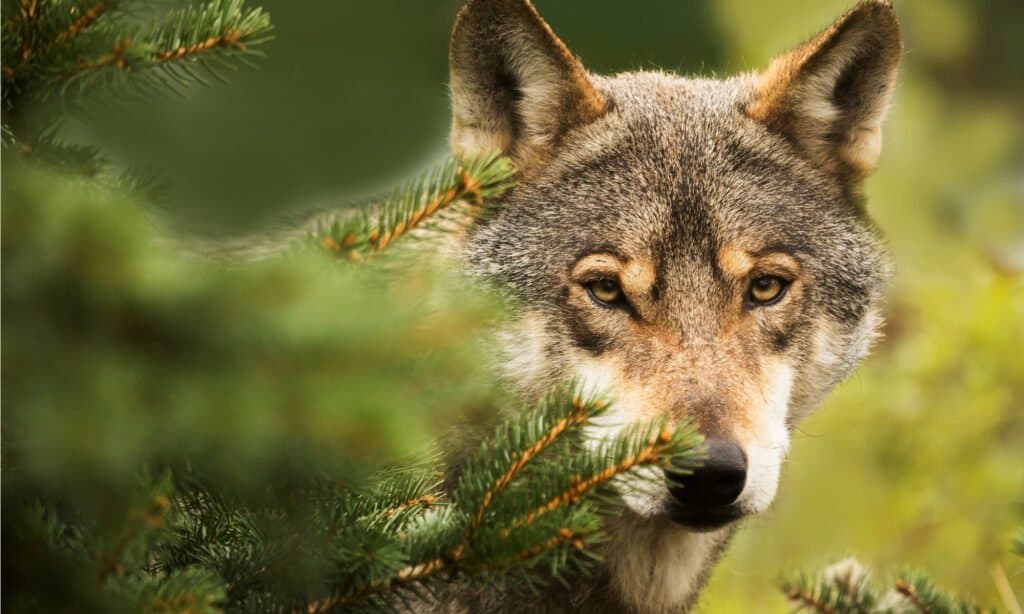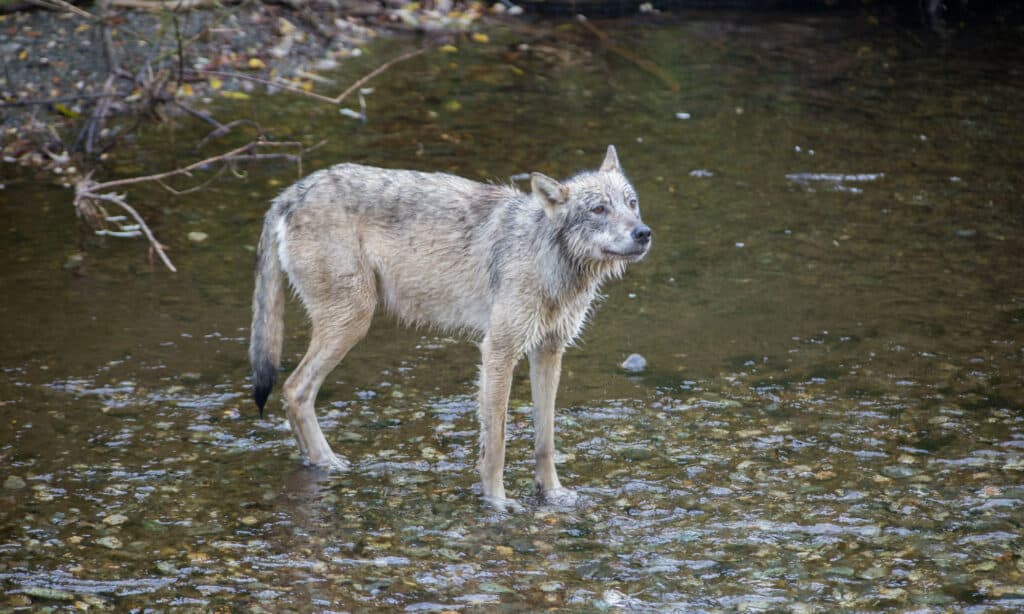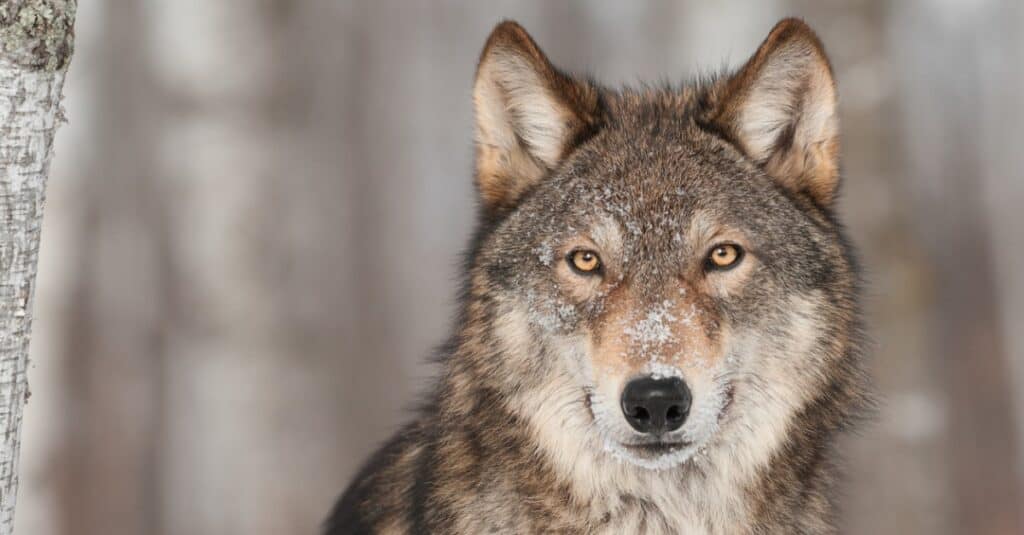Believe it or not, a pack of wolves known as the sea wolves live in the Pacific Northwest and are oceanic hunters.
No, the Vancouver coastal sea wolf isn’t sprouting gills and fins. They’re just continuing what they’ve been doing for generations: combing the beach for food. It’s more than that, though. They’re voracious eaters, swimmers, and a sign that the environment really can affect how we evolve. Let dive into these “sea wolves” and find out why wolves from the Pacific Northwest are becoming the ocean’s newest predators!
The Background on “Sea Wolves”

Seal wolves are found on Vancouver Island, which is north of cities like Vancouver and Seattle.
©Michal Ninger/Shutterstock.com
When we hear of wolves, we think of the grey wolves that inhabit Yellowstone National Park. These wolves may be related, but they are a different type of wolf. Sea wolves comb the beach for fresh food, munching on fish, seals, and river otters, making up 90% of what they eat.
The coastal sea wolf weighs in at around 60-70 lbs depending and comes in grays, browns, blacks, and on occasion, white. Each wolf’s fur is its unique blend of colors that can both stand out or blend in with the murky shoreline, depending on their needs.
Sea wolves can swim like otters and hunt like bears, eating fish and other animals. In fact, during salmon spawning season, salmon make up 25% of their diet. They don’t have too much competition in the way of other land animals, so they eat their fill.
These coastal wolves have been spotted eating whale carcasses as well. They also lick barnacles, scoop fish eggs found on kelp, and catch their own fish or other animals.
Coastal wolves are known for their ability to swim miles across the ocean to other islands. They rotate where they live depending on the seasons, where the salmon flow, and other factors that we might not be privy to but are natural instincts.
Why Do Sea Wolves Eat Fish?

Sea wolves get about 90% of their diet from the ocean.
©Ghost Bear/Shutterstock.com
In Wolves in the Land of Salmon, David Moskowitz writes, “Wolves also reflect our cvv with the world around us. We love them, we hate them, we fear them, we idolize them, we blame them, we are fascinated by them, feelings that mirror our changing relationship with our environment and the evolving ethical guidelines that drive our behavior within it.”
What he means by this is that wolves have long been a heated topic in the United States. How we feel about them reflects how we think about the environment, including our lack of care in how we treat it.
Where wolves live matters, and can even change their genes through evolution.
A study in Molecular Ecology proved that the wolves who thrived in coastal Alaska were genetically different from the grey wolves found inland. This proves that ecotypes can affect diversity. An ecotype is a population that is distinct from other populations based on their habitats and genetics.
Maybe these wolves were originally the same as the ones inland that hunt caribou or elk, but over time they evolved. This evolution meant they learned to thrive fully on seafood and even shellfish. Yes, they eat shellfish.
Spotted digging up clams, the sea wolves can crack them with their strong bite to get to the goodness inside. These wolves have such a diverse palate compared to others of their kind.
The pack that lives on the coast does not eat anything else. They have evolved not to need to hunt for deer or the other usual dietary choices.
How Did the Sea Wolves Genetics Change?

ea wolves genetics changed do to their habitat and what they primarily consume.
©Ghost Bear/Shutterstock.com
A research study published in 2014 shows the relationship that the Vancouver coastal sea wolf has with its natal environment. Fecal samples of more than 116 different wolves showed a clear difference in what the wolves ate despite the distances they could roam.
Wolf poop, or scat, can tell a lot about a wolf. Within the scat, there is usually hair from the wolves grooming themselves or others in their packs. This can help when it comes to testing for genetic makeup.
Testing the scat also reveals the wolf’s diet, and scientists were surprised to learn that the Vancouver coastal sea wolves in question only ate “seafood”, or animals from the sea. Even though they lived close to packs of wolves further inland, they didn’t hunt deer at all.
This study also proved that what they eat can change their genetics over time. This causes them to grow separately from the inland wolves even though they were within a thirty-mile radius of the coastal wolves.
The gene testing showed that habitats were influences on the wolves, likely due to the fact that wolves are far-ranging and might have different habitats to evolve with. Where they live and what they eat can, over time, force them to evolve in a way that keeps them in that area.
Are Sea Wolves New?

Sea wolves are not new, and have been around for generations.
©Holly Kuchera/Shutterstock.com
There is evidence to show that this pack of sea wolves has been around for generations. For too long, the West as a whole has ignored indigenous people when it comes to their history and facts they may have about surrounding flora and fauna. The indigenous of Alaska and British Columbia have historical legends about sea wolves.
A study in Frontiers in Ecology and the Environment fought to prove that Indigenous Knowledge had more to contribute to modern Western science than had been allowed. Indigenous Knowledge had been wholly underrepresented in the past for the myriad of ways it could assist with land-specific science and history.
Over many years Indigenous Knowledge has contributed more to science than the broader population realizes. This study proved that scientists should collaborate with local indigenous people to benefit their research and the communities around them fully.
Indigenous Knowledge reveals legends about the sea wolves, known as Gonakadet or Konakadeit, colloquially called the Sea-Wolf. These say that a sighting of the wolves means good luck.
The historical significance of this shows this isn’t a new phenomenon, even before the genetic testing. This indicates that the wolves have been around longer than expected and gives a more substantial base to work off of.
Evolution is a wondrous thing, as are these sea wolves, swimming through chilling waters and consuming other sea animals as they go.
The photo featured at the top of this post is © Yair Leibovich/Shutterstock.com
Thank you for reading! Have some feedback for us? Contact the AZ Animals editorial team.






